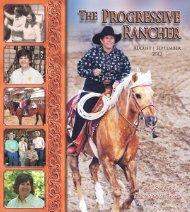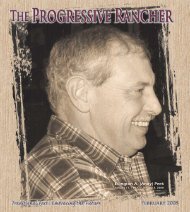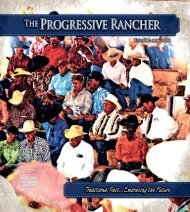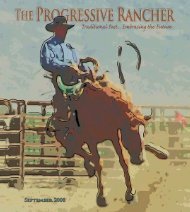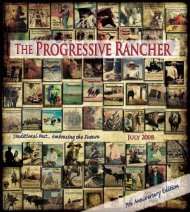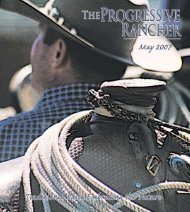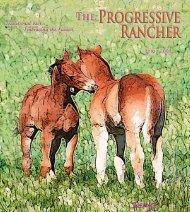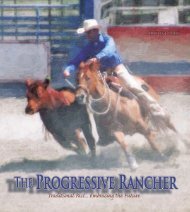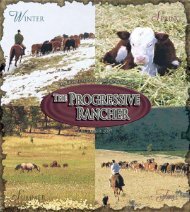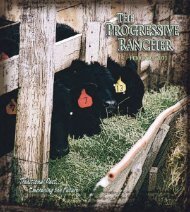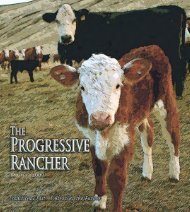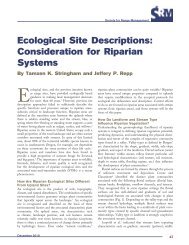NCA 2009 President's Award Recipient - The Progressive Rancher ...
NCA 2009 President's Award Recipient - The Progressive Rancher ...
NCA 2009 President's Award Recipient - The Progressive Rancher ...
You also want an ePaper? Increase the reach of your titles
YUMPU automatically turns print PDFs into web optimized ePapers that Google loves.
Table 2. Vegetation Cover by Treatment, 2006 and 2010<br />
expected after mechanical treatment. Shrub, forb and perennial grass totals increased,<br />
shrubs and forbs substantially. For simplicity, the tables do not include<br />
statistical analysis technicalities. Results shown are consistent with statistical<br />
analysis results currently submitted for publishing.<br />
We also grouped the data by treatment method to demonstrate any differences<br />
in vegetation response between the methods (Table 2). Looking at the<br />
data by treatment, we see total reduction in tree cover for all treatments except<br />
the veg-crusher/bulldozer method, which left several live trees. Shrub cover<br />
increased similarly across all treatment methods. Forb cover more than doubled<br />
for all treatments except for mastication. Alternatively, the mastication treatment<br />
showed a large increase in perennial grass cover. Other treatments showed<br />
a very small increase in perennial grass cover and a decrease for the bulldozer<br />
method. Cheatgrass cover did not change. Its presence was minimal before<br />
treatment and did not increase. <strong>The</strong> method leaving the least amount of slash or<br />
biomass residue was lop, pile and burn.<br />
<strong>The</strong> largest variation among the treatment methods was cost. Table 3 shows<br />
the costs for each method used in the research project and the current going<br />
rates. Due to the small acreage for the research project, costs for some methods<br />
were inflated. <strong>The</strong> chaining was conducted at normal cost since there were 700<br />
more acres chaining within the project area. <strong>The</strong> least expensive method was<br />
the bulldozer and one-way chaining. <strong>The</strong> most expensive was the feller-buncher<br />
and chipper. <strong>The</strong> lop, pile and burn method was effective in reaching objectives,<br />
however it is very labor intensive, and thus, expensive. Mastication is at least<br />
double the cost of lop and scatter.<br />
Table 3<br />
Treatment Methods<br />
Project Rates<br />
$/acre<br />
Normal Rates<br />
$/acre<br />
Lop and scatter $525 $100-200<br />
Lop, pile, burn $935 $400-500<br />
Fecon shredder/masticator $460 $400<br />
Bulldozer or one-way chaining $83 $100<br />
Feller-buncher-chipper $2,000 $1000<br />
We can infer from the results that we met our goals for the project. We reduced<br />
tree cover and increased shrubs, forbs, and grass cover without introducing<br />
more cheatgrass onto the site. We have minimized the potential for a large<br />
fire moving through the study area and the rest of the project area. Flourishing<br />
shrubs and herbaceous species should improve wildlife habitat for ungulates<br />
and birds. We, also, more fully understand the variety of methods used to accomplish<br />
mechanical removal of trees. Finally, monitoring protocols are in place<br />
for future analysis and evaluation.<br />
All treatment options seemed to meet project objectives…perhaps some<br />
better than others, primarily economically. Though veg-crushing or one-way<br />
chaining is cheap, it does not accomplish thorough removal of pinyon and<br />
juniper. More expensive two-way chaining increases tree and shrub mortality.<br />
Shredding machines like the feller-buncher and masticator can be expensive, but<br />
wood chip residue is preferable to logs and limbs when considering aesthetics,<br />
fire, and pathogen hazards. On the other hand, dead biomass nutrients remain<br />
on site that may benefit living organisms. Machines are restricted by topography<br />
and road access, while chainsaw crews are more versatile on difficult terrain.<br />
Pinyon and juniper trees with low to medium cover are optimal for chainsaw<br />
crew lop and scatter methods.<br />
Options and considerations are plentiful in planning treatments to reduce<br />
pinyon and juniper cover. Among many things, we must consider available funding,<br />
terrain and access difficulty, and last, but not least, our desire of healthy and<br />
resilient ecological condition of our valuable sagebrush ecosystems.<br />
www.progressiverancher.com <strong>The</strong> <strong>Progressive</strong> <strong>Rancher</strong><br />
April 2013 21



